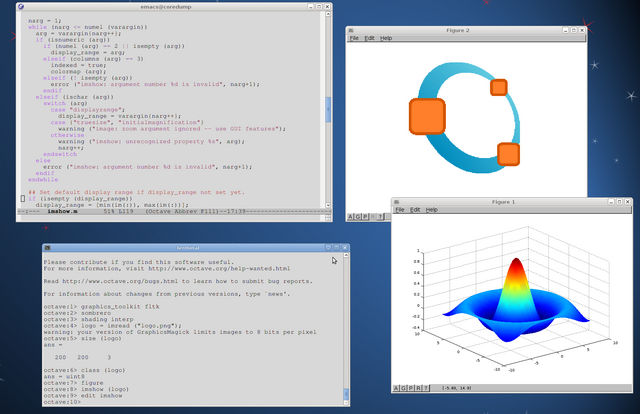There are quite a few software applications that are considered indispensable for a variety of specialized subject areas of academia and research, such as engineering, science, and economics. And the popular MATLAB is an ideal example of that. Built around the proprietary scripting languge of the same name, the MATLAB environment is used by millions of users for their numerical computing needs, with advanced usage cases including creation of user interfaces, and even interfacing with programs written in other languages. And if it’s really that awesome, MATLAB must be the only one of its kind, right?
Wrong, as there are many great MATLAB alternatives that you can use. So let’s wait no more, and jump right in!
Best MATLAB Alternatives
1. Wolfram Mathematica

Deveoped by Wolfram Research, the pioneers of computational software, Mathematica comes with a truckload of features for all your mathematical computational needs. The latest version boasts over 700 new functions, as well as multiple function libraries and geo visualization/animation tools. And that’s just the tip of the iceberg. From 2D/3D image processing to enhanced signal processing, and from automated machine learning to enhanced graphical computations, Mathematica can handle it all. Then there are powerful tools for connecting to the systems based on DLL, SQL, CUDA, OpenCL, and Fortran. A curated API framework allows for external device connectivity, and it can also connect with programming languages like Haskell, AppleScript, and Clojure.
Platform Availability: Windows, Mac OS X, Linux
Pricing: Starts at $149 per year. Pricing varies according to usage cases. 15 days trial available
2. Maple

Having a powerful Math engine, Maple is a pretty feature heavy MATLAB alternative. It lets you enter problems in traditional mathematical notation, and allows creation of custom interfaces. Maple includes a dynamically typed, imperative-style programming language, identical to Pascal. And of course, it can interface with other languages (e.g. C, Java) as well. It has over 5000 functions covering every area of mathematics, and numerous useful modules like equation editor, variable manager, and live-data plots. Even hand written symbols are recognized, and it can connect with MATLAB as well. Thanks to its versatility, Maple’s usage extends in areas like financial modeling, control design, and statistical data analysis. In fact, it was instrumental in the discovery of the mathematics based Gomboc shape.
Platform Availability: Windows, Mac OS X, Linux
Pricing: Starts at $99. Pricing varies according to usage cases. 30 days trial available
3. GNU Octave

Want a powerhouse free and open-source alternative to MATLAB? GNU Octave is all you need. Comprised of a high-level interpreted language, it’s primarily meant for numerical computations, but can also handle extensive data manipulation and visualization just as good. Probably one of its most unique features is the interactive command line interface, used for solving linear and non-linear problems numerically. Moreover, the Octave language is quite identical to MATLAB, which makes for easy portability of most programs. Other notable features include command history, variable name completion, and a wide variety of packages, which let the software do everything from solving Differential Advection Reaction (DAR) Partial Differential Equations, to interfacing with SQL databases.
Platform Availability: Windows, Mac OS X, Linux
Pricing: Free
4. Scilab

Maintaining a healthy balance between features and ease of use, Scilab is a great open-source numerical computational package, that you can use in place of MATLAB. It comes with a high-level, numerically oriented programming language. However, due to features such as dynamic typing and automatic memory management, it becomes possible to express numerical problems using reduced amount of code. Scilab also comes with a free “Xcos” package (analogous to MATLAB’s Simulink) for effortless modeling and simulation of explicit and implicit dynamical systems. The syntax of Scilab is largely based on MATLAB. Other regular functionalities, such as 2D/3D visualization, control system analysis etc. are there too. Oh, and there are quite a few external modules available for it too, for doing things like network computations and GPU computing.
Platform Availability: Windows, Mac OS X, Linux
Pricing: Free
5. SageMath

Covering just about everything in mathematics (algebra, calculus, number theory etc.), SageMath is a robust numerical computing software that uses a Python like syntax, with support for procedural, functional, and object oriented constructs. Perhaps its standout feature is a browser based notebook that lets you review and re-use previous inputs/outputs, including everything from graphics to text annotations. It’s compatible with almost all major web browsers, and the notebooks can be accessed both locally, and over secure HTTP connections. Its Python standard library includes tools for connecting to SQL, FTP etc., and SageMatch can be even called from within Mathematica (mentioned previously). It’s built from nearly 100 open-source packages, with distributed computing support and an automated test suite rounding up the feature list.
Platform Availability: Windows, Mac OS X, Linux
Pricing: Free
6. Julia

Strictly speaking, Julia is not a full “alternative” to MATLAB, in the sense that it’s essentially a high-level, dynamic programming language, intended for numerical computing. However, you can easily use it via the free Juno IDE. As for the language itself, it comes with a sophisticated compiler, with support for distributed parallel computing, and a large mathematical function library. And thanks to the active developer community, the list of external packages is steadily growing too. It’s designed for cloud computing, and the “multiple dispatch” approach makes it easy to define function behavior across many argument type combinations. You also get Lisp like macros, shell-like capabilities for easily managing other processes. Oh, and Julia conferences are held at none other than the world-renowned MIT itself.
Platform Availability: Windows, Mac OS X, Linux
Pricing: Free
SEE ALSO: 10 Free Online Resources For Learning Linux
Do numerical computation better, even without MATLAB
As the undisputed leader when it comes to numerical/mathematical computing, MATLAB is obviously the most feature loaded computational package out there. But if you’re looking for something different, there are quite a few great alternatives available, as evinced above. Try them out, and sound off your findings in the comments section below.






